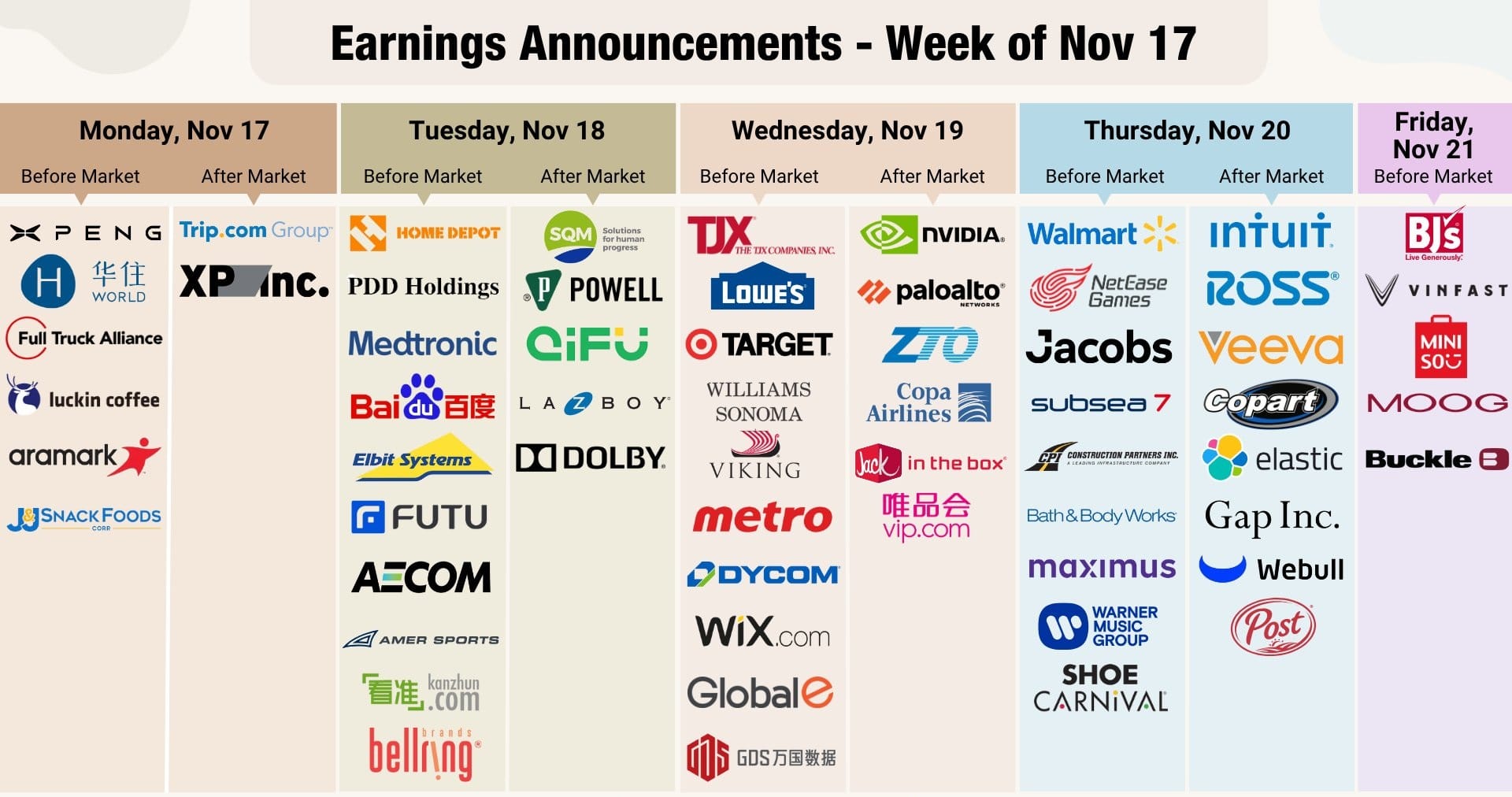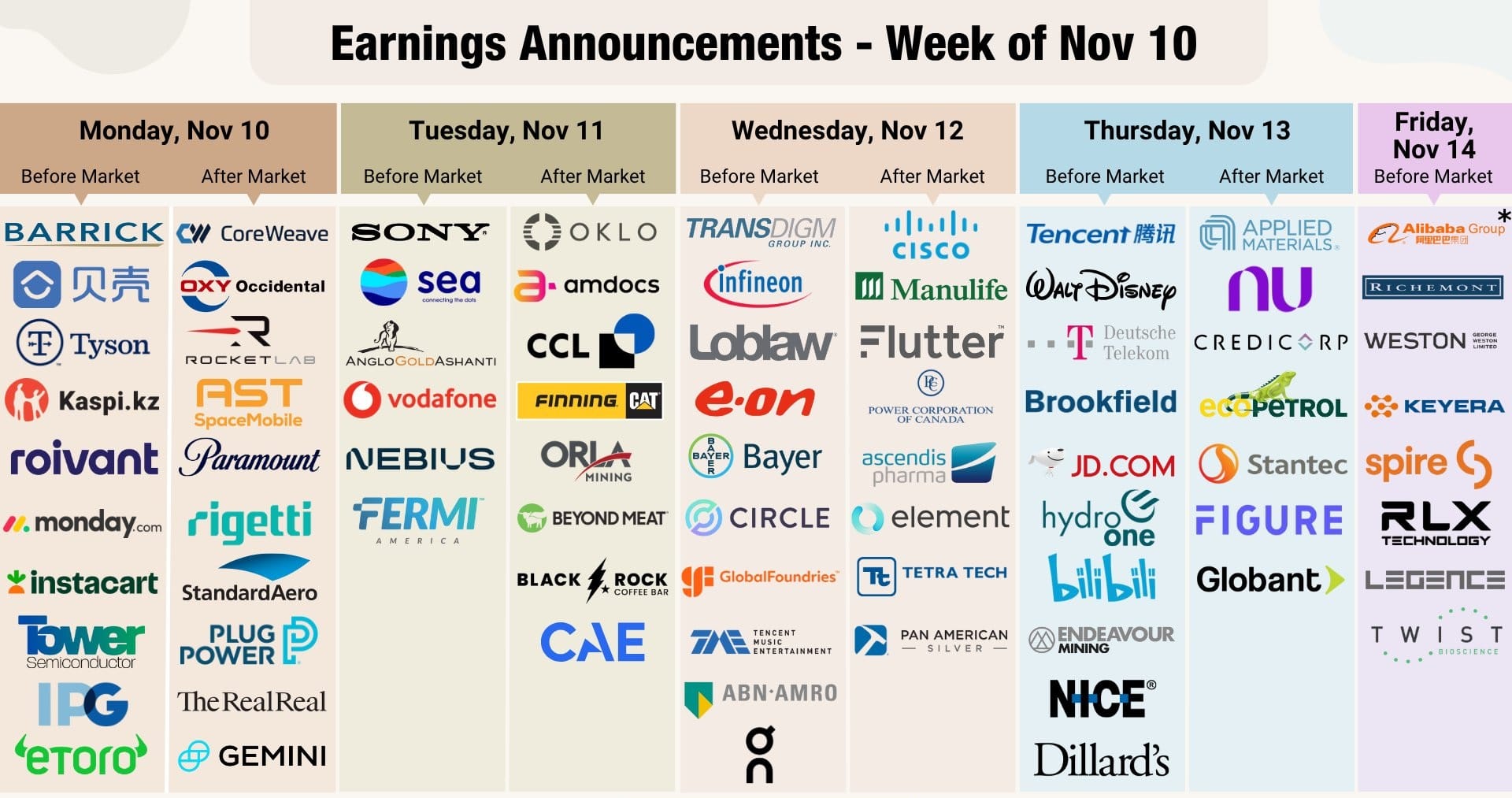Introduction: Where Micro Performance Meets Macro Forces
The rhythm of earnings season often determines the tone of the stock market, as corporate stories intersect with broader economic data. Each quarterly release is a statement of execution and resilience, revealing whether companies can navigate inflation, interest rates, and shifting consumer demand.
This week, an intense sequence of corporate results coincides with a wave of key economic indicators across major economies. These dual narratives—micro and macro—will define investor sentiment and determine whether recent rallies can sustain momentum or retreat under macro pressure.
Investors are now confronting a critical question: are rising profits sufficient to justify extended valuations, or will economic headwinds overshadow the optimism? The answer lies in the fine print of balance sheets and policy statements that will unfold in the coming days.
Part I: Corporate Earnings—Performance Under the Spotlight
Rigetti Computing (RGTI): The Quantum Profitability Test
Among this week’s corporate results, Rigetti Computing’s update stands out as a symbol of high-risk innovation. The company is projected to post a $0.05 loss per share on $2.39 million in revenue—a modest 0.5% year-over-year rise that underscores both technical progress and commercial limitations.
Despite the tiny revenue base, Rigetti’s stock has climbed more than 108% since its last report and trades nearly 96% above its 200-day moving average. The stock market is clearly pricing in the potential of quantum computing more than its present performance.
Options markets imply a volatile 17.6% post-earnings move, signaling intense speculation. Put buying at the $20 strike reveals hedging activity, as some traders prepare for a correction. The narrative hinges less on the reported loss and more on management’s clarity regarding technological milestones, commercialization of quantum volume, and partnerships that can turn innovation into contracts.
A sector defined by long horizons demands patience—but Rigetti’s valuation leaves little margin for error.
CoreWeave (CRWV): Scaling the Infrastructure Behind AI
CoreWeave embodies the hardware backbone of the artificial-intelligence boom. Expected to post a $0.39 per-share loss on $1.28 billion in revenue, the company’s top line reflects aggressive expansion into GPU-driven data centers.
Investor enthusiasm remains elevated despite a 21.8% stock decline since the previous report. The divergence between near-term losses and long-term opportunity defines investor sentiment here. Over half of surveyed investors anticipate an earnings beat, showing belief in the durability of AI demand.
However, a 47.3% jump in short interest illustrates skepticism about costs, margins, and debt management. Downward revisions to earnings forecasts point to the capital-intensive nature of scaling. The forward guidance will decide whether CoreWeave remains a growth darling or slips into the “too expensive to scale” category.
Options traders buying $140 calls indicate bets on a rebound into year-end. Should management confirm sustained utilization rates and margin recovery, the stock market may reward the conviction.
BigBear.ai (BBAI): Navigating Decline with Strategic Rebuild
BigBear.ai represents the opposite side of the growth spectrum—contraction. The forecast: a $0.06 loss per share and a 25% year-over-year revenue fall to $31.13 million.
This contraction likely reflects delayed contracts and competitive displacement in defense and analytics. The company’s muted 17% price gain and 12.8% rise in short interest suggest minimal confidence in its turnaround story.
For investors tracking earnings, BigBear’s narrative is less about near-term recovery and more about signaling operational focus. Analysts expect commentary on contract renewals and cost control, both essential to restoring credibility. Any mention of new partnerships or restructuring could serve as a catalyst for sentiment reversal, though speculative risk remains high.
Pagaya Technologies (PGY): Profitability in the Age of AI Finance
Pagaya stands apart in a week dominated by losses. Expected to report $0.66 per share in profit on $339 million revenue—a 31.8% annual increase—the fintech firm shows that AI can deliver not just innovation but earnings leverage.
Unlike speculative peers, Pagaya’s profitability aligns with steady execution in asset and credit management. Over 60% of investors anticipate an earnings beat, supported by consistent guidance between $330–$350 million.
Still, despite rising profits, the stock has fallen 32% since the last report. The contradiction highlights the tension between fundamentals and macro caution: as rates stay elevated, credit-sensitive businesses face valuation compression. Upward revisions to consensus estimates reinforce the core strength of Pagaya’s model and may position it for recovery as monetary conditions ease.
Barrick Mining (B): Riding the Commodity Supercycle
Barrick’s expected $0.57 earnings per share on $4.22 billion revenue—nearly a tenfold increase year over year—positions it as a stable play in a volatile stock market. This jump likely stems from commodity price cycles and potential asset sales, but it underscores operational resilience amid inflation and currency swings.
With modest 6.6% implied volatility, Barrick’s investor sentiment profile contrasts sharply with high-growth tech names. It attracts those seeking defensive yield and leverage to gold’s macro role as a hedge against policy risk.
Rocket Lab USA (RKLB): Balancing Innovation and Cash Flow
Rocket Lab is expected to post a $0.09 loss per share alongside 42.9% revenue growth to $149.8 million. The company straddles innovation and execution: its satellite-launch capabilities continue to expand, yet profitability remains distant.
Investor sentiment is mixed. While the bearish narrative centers on rising costs, a surprising 62.9% of analysts still expect an earnings beat—proof that faith in space commercialization persists. Options markets show balanced call-and-put activity, suggesting traders await clarity before committing directionally.
The takeaway: in sectors defined by innovation, incremental execution updates matter more than headline losses.
Beyond Meat (BYND) and AST SpaceMobile (ASTS): From Turnaround to Transformation
Beyond Meat continues to struggle with shrinking demand and brand fatigue. Expected to post another loss amid revenue contraction, its depressed valuation reflects deep skepticism. High short interest and weak momentum highlight structural challenges in pricing, distribution, and consumer adoption.
AST SpaceMobile, meanwhile, is in the pre-revenue hyper-growth phase, anticipating a massive 1,785% surge year over year. The market views it as a speculative frontier bet, hinging on successful deployment of its space-based broadband network. Operational progress updates will outweigh raw earnings data in influencing the stock market response.

Part II: Macroeconomic Forces—Reading the Global Data Pulse
While corporate announcements command attention, economic data this week carries equal weight. Inflation, employment, and central-bank signals from Asia to North America will shape expectations for rates, growth, and liquidity—the ultimate drivers of valuations.
Asia-Pacific Focus: Inflation and Policy Patience
China remains the region’s focal point as it battles persistent deflation. Negative CPI readings highlight sluggish domestic demand and property-sector weakness. Analysts expect marginal stabilization, but further fiscal and monetary support may be required to reignite consumption.
Japan’s Bank of Japan will release its Summary of Opinions following a 7-2 vote to hold rates. Subtle shifts in tone could preface a policy normalization debate, with markets sensitive to any indication that yield-curve control might ease.
In New Zealand, the RBNZ’s Q4 Inflation Expectations Survey will test whether businesses still see price pressures within the 1–3% target band. A higher forecast could dampen expectations for rate cuts after headline inflation unexpectedly rose to 3%.
Australia’s upcoming employment data will reveal whether its labor market is cooling gently or sharply. With unemployment near 4.5%, a balanced report could preserve the central bank’s neutral stance, sustaining regional stability.
Europe: Balancing Growth and Wage Pressure
In the United Kingdom, the September jobs and wage data will be pivotal. The Bank of England’s recent hold decision rested on signs that services inflation may be softening. Should wage growth continue moderating, policy doves will find support for an extended pause.
Across the Eurozone, the ZEW Economic Sentiment index for Germany and the bloc will gauge confidence amid weak manufacturing. Later, industrial-production data will provide tangible confirmation—or contradiction—of recovery hopes.
For investors tracking earnings in European equities, the relationship between labor costs and profit margins remains the key tension: easing wage pressure could bolster valuations, while renewed inflation fears would compress them again.
North America: Policy Signals and Energy Balance
Canada’s central bank minutes from its 2.25% rate decision will offer crucial insight into how deeply members support the current pause. Language around trade disruptions and household debt will determine whether another cut or extended hold is likely in early 2026.
In the United States, the NFIB Small Business Optimism Index and ADP employment data will preview the health of the real-economy backbone. As large-cap earnings dominate headlines, small-business trends often foreshadow shifts in hiring and spending sentiment that ripple through the broader stock market.
Meanwhile, three key energy reports—the EIA’s Short-Term Energy Outlook, OPEC’s MOMR, and the IEA’s OMR—will together shape forecasts for oil demand, supply, and price stability. Energy equities, already rebounding on tightening inventories, will take direction from these projections.

Part III: Synthesis—Linking Earnings, Sentiment, and Data
Profitability Meets Policy
The week ahead illustrates how intertwined earnings and economic data have become. Technology firms continue to trade on growth narratives, yet profitability now carries heavier weight as rates remain high. Pagaya’s results, juxtaposed with Rigetti’s and CoreWeave’s losses, reveal a market increasingly rewarding execution over ambition.
In contrast, commodity and industrial sectors—Barrick, Rocket Lab—benefit from tangible assets and diversified cash flows, acting as hedges against volatility. The sectoral rotation within the stock market highlights a subtle shift toward fundamentals and away from speculative excess.
Regional Divergence and Investment Strategy
China’s deflationary environment, Japan’s cautious normalization, and the Anglo-economies’ gradual disinflation represent diverging policy paths. For global portfolios, this divergence introduces opportunity but also requires precision.
While Asian equities may respond to stimulus headlines, Western markets remain tethered to inflation and wage metrics. The interplay of rate expectations, bond yields, and investor sentiment will dictate sector leadership through year-end.
Inflation’s Evolving Narrative
Though inflation appears subdued in North America and Europe, scattered data from China and New Zealand remind markets that disinflation is uneven. Any surprise acceleration could quickly shift expectations for central-bank policy, pushing yields higher and pressuring valuation multiples.
The lesson for investors: treat every CPI and wage release not as background noise but as a live input into stock market pricing models.
Part IV: Strategic Implications for Investors
1. Growth vs. Profit Reality
The juxtaposition between quantum computing pioneers like Rigetti and profit-makers like Pagaya reveals where capital discipline is returning. The earnings narrative is shifting from “how fast you grow” to “how efficiently you grow.”
In a higher-rate world, unprofitable growth models face limited tolerance. Investors should favor companies demonstrating clear operating leverage or improving cash conversion—factors that sustain valuations even amid volatility.
2. Sector Positioning in a Volatile Market
High-innovation tech remains prone to sentiment swings, while commodities and financials gain favor as defensive allocations. The stock market has entered a selective phase where rotation, not broad rallies, defines performance.
AI infrastructure providers like CoreWeave and profitable fintechs like Pagaya may command premium multiples, but their guidance will need to reaffirm scalability to justify sustained inflows.
3. The Central Bank Overlay
Economic data from China to the US underscores one reality: monetary policy divergence is widening. Investors must calibrate expectations regionally. For example, easing in Canada contrasts with Japan’s slow normalization, creating relative-value plays in currency and equity hedging.
The direction of real yields remains the most powerful determinant of equity risk appetite. Sustained disinflation supports a gradual multiple expansion, but any upside surprise in inflation could unwind that narrative quickly.
4. Sentiment as a Market Catalyst
The connection between investor sentiment and positioning has never been more visible. Options markets reflect both fear and hope—a combination that fuels volatility. Contrarian signals, such as rising short interest amid bullish fundamentals, can often precede rebounds, while euphoric momentum tends to invite corrections.
Monitoring sentiment shifts, particularly around high-beta sectors, will remain essential for tactical traders.
Conclusion: Reading the Week as a Market Narrative
This week’s dense lineup of earnings, corporate results, and economic data forms more than a sequence of headlines—it’s a coordinated test of market conviction. The stock market now lives in a space where profitability, inflation, and psychology converge.
For disciplined investors, the opportunity lies in synthesis: interpreting not just what companies report, but how macro conditions validate or contradict those reports. The coming days will decide whether markets continue pricing optimism—or begin demanding tangible delivery.
The story of earnings this week is not only about numbers. It’s about trust in execution, balance in growth, and alignment between micro performance and macro stability.












